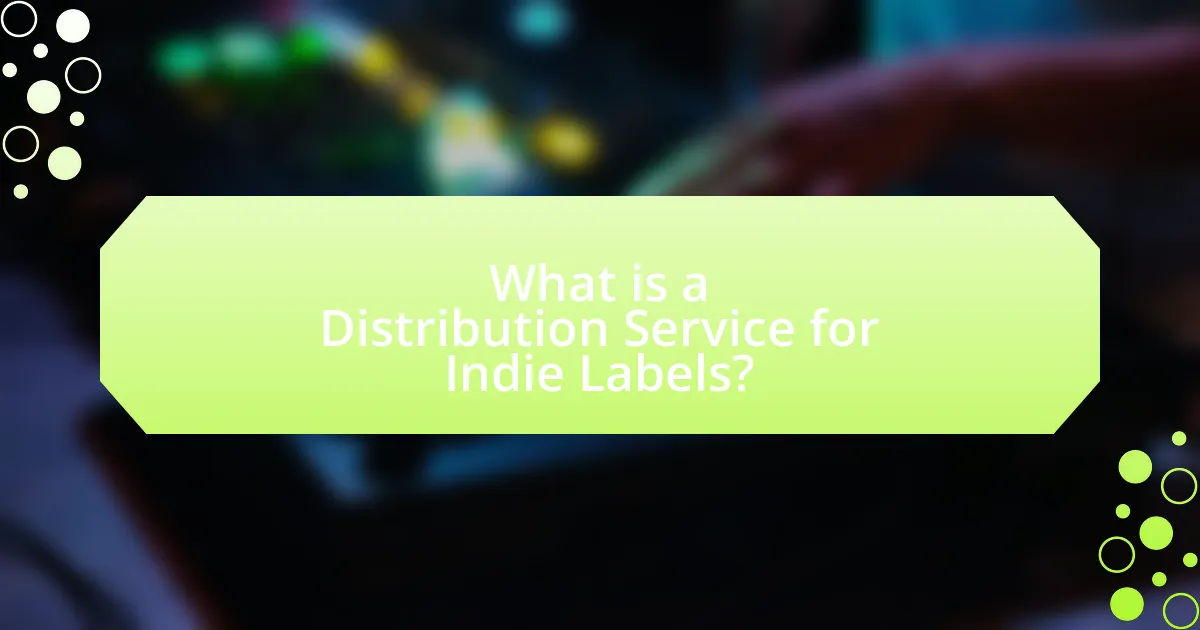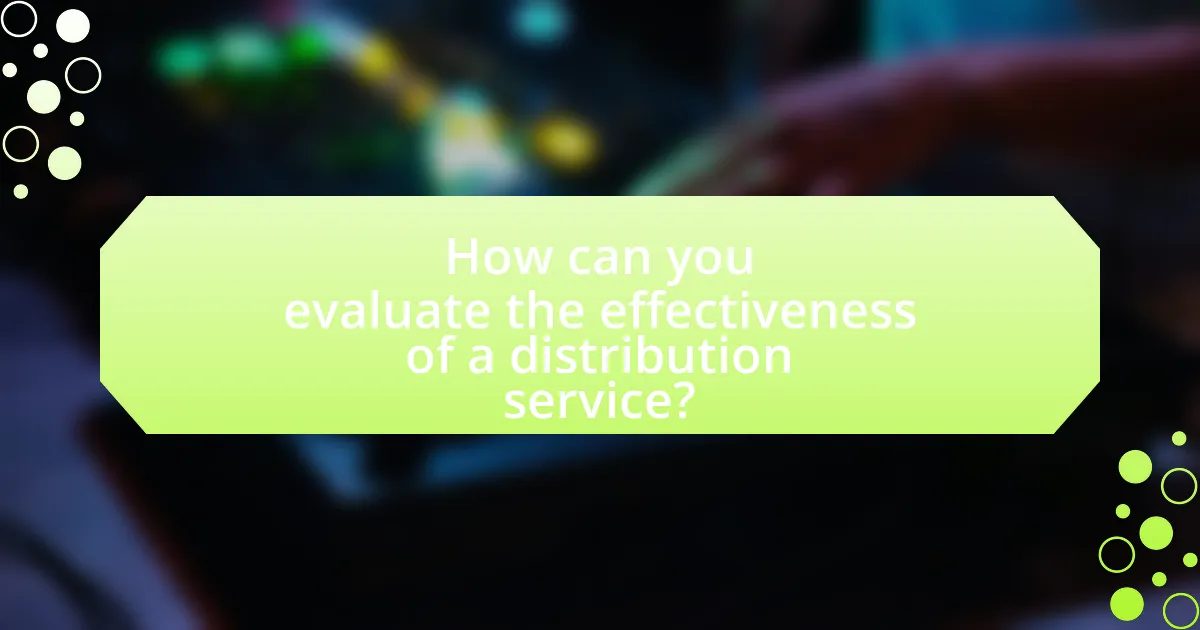The article focuses on the essential aspects of selecting the right distribution service for independent music labels. It outlines the functions and key features of distribution services, such as digital distribution, royalty management, and marketing support, while contrasting them with traditional record labels. The importance of choosing an appropriate service is emphasized, as it directly affects an indie label’s reach, revenue, and overall success. Additionally, the article discusses factors to consider when selecting a service, common pricing models, and best practices for maintaining a productive relationship with distributors, ultimately guiding indie labels in making informed decisions to enhance their music distribution strategies.

What is a Distribution Service for Indie Labels?
A distribution service for indie labels is a platform that facilitates the distribution of music from independent artists to various digital and physical retail outlets. These services enable indie labels to reach a wider audience by providing access to streaming platforms, online stores, and sometimes physical distribution channels. For instance, companies like DistroKid and TuneCore allow indie labels to upload their music and manage sales, royalties, and analytics, thereby streamlining the process of getting music into the hands of listeners.
How do distribution services function for independent music labels?
Distribution services for independent music labels facilitate the process of getting music from artists to various platforms and audiences. These services handle the logistics of distributing music to digital streaming platforms, physical retailers, and other outlets, ensuring that the music is available for purchase or streaming. They often provide tools for tracking sales, managing royalties, and marketing music, which are essential for independent labels that may lack the resources of larger companies. For instance, services like DistroKid and TuneCore allow independent labels to upload their music, select distribution channels, and receive analytics on performance, thereby streamlining the distribution process and maximizing reach.
What are the key features of a distribution service?
The key features of a distribution service include digital distribution, royalty management, marketing support, and analytics reporting. Digital distribution allows music to be delivered to various streaming platforms and online stores, ensuring broad accessibility. Royalty management systems track sales and ensure accurate payment to artists, which is crucial for financial transparency. Marketing support often includes promotional tools and strategies to enhance visibility and reach, while analytics reporting provides insights into performance metrics, helping artists understand their audience and optimize their efforts. These features collectively enhance the effectiveness and efficiency of music distribution for indie labels.
How do distribution services differ from traditional record labels?
Distribution services primarily focus on delivering music to digital platforms, while traditional record labels manage a broader range of activities including artist development, marketing, and physical distribution. Distribution services typically charge a fee or take a percentage of sales without offering additional support, whereas traditional record labels often invest in artists and provide resources for promotion and production. For example, in 2020, the global digital music distribution market was valued at approximately $1.5 billion, highlighting the growing preference for distribution services among independent artists seeking more control over their music without the commitments of a traditional label.
Why is choosing the right distribution service important for indie labels?
Choosing the right distribution service is crucial for indie labels because it directly impacts their ability to reach audiences and generate revenue. A suitable distribution service ensures that music is available on multiple platforms, maximizing exposure and sales opportunities. For instance, services that offer wider digital reach can lead to increased streaming numbers and higher sales, which are vital for the financial sustainability of indie labels. Additionally, the right service can provide valuable analytics and marketing support, helping labels make informed decisions about their promotional strategies.
What impact does distribution have on an indie label’s success?
Distribution significantly impacts an indie label’s success by determining the reach and accessibility of its music. Effective distribution channels enable indie labels to place their music on major streaming platforms and physical retail outlets, which increases visibility and potential sales. For instance, a study by MIDiA Research indicates that independent artists who utilize digital distribution services see a 30% increase in streaming revenue compared to those who do not. This demonstrates that strategic distribution choices can directly influence an indie label’s market presence and financial performance.
How can the wrong distribution choice affect an artist’s career?
The wrong distribution choice can significantly hinder an artist’s career by limiting their reach and revenue potential. For instance, if an artist selects a distribution service that does not effectively promote their music or lacks access to major streaming platforms, their audience growth may stagnate. Additionally, poor distribution can lead to lower sales and streaming numbers, which directly impacts an artist’s income and visibility in a competitive market. According to a report by MIDiA Research, artists who utilize effective distribution channels can see up to 30% higher revenue compared to those who do not. Therefore, the choice of distribution service is crucial for maximizing an artist’s career opportunities and financial success.

What factors should you consider when selecting a distribution service?
When selecting a distribution service, consider factors such as pricing structure, distribution reach, and additional services offered. Pricing structure is crucial as it affects your profit margins; for instance, some services charge a flat fee while others take a percentage of sales. Distribution reach is important because it determines where your music will be available, including platforms like Spotify, Apple Music, and others. Additionally, evaluate the extra services provided, such as marketing support, analytics, and customer service, which can enhance your overall experience and effectiveness in reaching your audience.
How do pricing structures influence your choice of distribution service?
Pricing structures significantly influence the choice of distribution service by determining the overall cost-effectiveness and profitability of distributing music. For indie labels, a transparent and flexible pricing model can enhance budget management, allowing for better allocation of resources. For instance, services that charge a flat fee per release or a percentage of sales can impact the label’s revenue differently; a flat fee may be preferable for high-volume releases, while a percentage model may suit labels with fewer releases but higher sales potential. Additionally, understanding hidden fees, such as those for additional services or distribution to specific platforms, is crucial for making informed decisions. Research indicates that indie labels often prioritize cost structures that align with their sales forecasts and marketing strategies, ensuring that distribution costs do not outweigh potential earnings.
What are the common pricing models used by distribution services?
Common pricing models used by distribution services include percentage-based fees, flat fees, and tiered pricing structures. Percentage-based fees typically charge a percentage of the revenue generated from sales, which aligns the distributor’s earnings with the artist’s success. Flat fees involve a fixed cost for distribution services, regardless of sales volume, providing predictability in expenses. Tiered pricing structures offer different service levels at varying price points, allowing artists to choose based on their needs and budget. These models are prevalent in the industry, as they cater to diverse financial strategies and artist requirements.
How can you assess the value of a distribution service based on its pricing?
To assess the value of a distribution service based on its pricing, compare the service’s costs against the features and benefits it offers. A distribution service that charges higher fees may provide additional services such as marketing support, analytics, or wider reach, which can justify the cost. For instance, if a service charges a 15% commission but includes promotional tools that can increase sales, the overall value may exceed that of a cheaper service with limited offerings. Evaluating customer reviews and case studies can also provide insights into the effectiveness of the service relative to its pricing, helping to determine if the investment aligns with your label’s goals.
What types of distribution services are available for indie labels?
Indie labels have access to several types of distribution services, including digital distribution, physical distribution, and hybrid distribution. Digital distribution services, such as DistroKid and TuneCore, allow indie labels to distribute music to streaming platforms like Spotify and Apple Music. Physical distribution services, like The Orchard, focus on distributing physical copies of music, such as vinyl and CDs, to retail outlets. Hybrid distribution services combine both digital and physical distribution, providing a comprehensive solution for indie labels to reach a wider audience. These services are essential for indie labels to effectively manage their music distribution and maximize their reach in the market.
What are the differences between digital and physical distribution services?
Digital distribution services deliver content electronically, while physical distribution services involve the tangible delivery of products. Digital distribution allows for instant access and global reach, enabling artists to distribute music through platforms like Spotify and Apple Music without the need for physical inventory. In contrast, physical distribution requires manufacturing, storage, and shipping of physical products such as CDs or vinyl records, which can incur higher costs and longer lead times. The global digital music revenue reached $23.1 billion in 2020, highlighting the growing preference for digital formats, while physical sales have been declining, indicating a shift in consumer behavior towards digital consumption.
How do aggregator services compare to direct distribution options?
Aggregator services streamline the distribution process by consolidating multiple platforms into one service, while direct distribution options require artists to manage each platform individually. Aggregators, such as DistroKid or TuneCore, provide a single point of access to various streaming services, simplifying the release process and often offering additional promotional tools. In contrast, direct distribution allows for more control over each platform’s settings and potentially higher revenue shares, but it demands more time and effort from the artist. According to a 2021 report by MIDiA Research, artists using aggregator services can release music faster and reach a broader audience, while those opting for direct distribution may benefit from personalized marketing strategies.

How can you evaluate the effectiveness of a distribution service?
To evaluate the effectiveness of a distribution service, analyze key performance indicators such as delivery speed, order accuracy, and customer satisfaction. Delivery speed can be assessed by measuring the average time taken from order placement to delivery, with industry benchmarks indicating that a delivery time of 1-3 days is optimal for customer retention. Order accuracy is determined by the percentage of orders delivered correctly, with a target accuracy rate of 98% or higher being standard in the logistics industry. Customer satisfaction can be gauged through surveys and feedback, where a Net Promoter Score (NPS) above 50 is considered excellent. By systematically reviewing these metrics, one can effectively gauge the performance and reliability of a distribution service.
What metrics should you track to assess distribution performance?
To assess distribution performance, track metrics such as sales volume, revenue generated, market reach, and customer engagement. Sales volume indicates the number of units sold, providing insight into demand. Revenue generated reflects the financial success of distribution efforts, while market reach measures the extent of audience exposure across platforms. Customer engagement metrics, such as streaming counts and social media interactions, reveal how well the distributed content resonates with the audience. These metrics collectively offer a comprehensive view of distribution effectiveness, enabling informed decisions for optimizing strategies.
How can sales data inform your choice of distribution service?
Sales data can inform your choice of distribution service by revealing which platforms generate the highest revenue and customer engagement for your products. Analyzing sales trends across different channels allows you to identify the most effective distribution methods, ensuring that you allocate resources to services that align with your target audience’s purchasing behavior. For instance, if sales data shows that a significant portion of your revenue comes from digital downloads on a specific platform, it would be prudent to prioritize that distribution service to maximize visibility and sales. Additionally, understanding geographic sales patterns can help you select services that cater to your primary markets, enhancing your overall distribution strategy.
What role does audience reach play in evaluating distribution effectiveness?
Audience reach is a critical metric in evaluating distribution effectiveness as it directly correlates with the potential audience exposure and engagement for a product. A wider audience reach indicates that the distribution service can deliver content to a larger number of consumers, enhancing visibility and increasing the likelihood of sales. For instance, a distribution service that connects with multiple streaming platforms and social media channels can significantly amplify an indie label’s presence, leading to higher streaming numbers and fan engagement. Research shows that distribution channels with extensive reach can lead to a 30% increase in audience engagement compared to those with limited access, underscoring the importance of audience reach in assessing distribution effectiveness.
What are the common pitfalls to avoid when choosing a distribution service?
When choosing a distribution service, common pitfalls to avoid include overlooking the service’s fees, failing to understand the distribution reach, and neglecting to review contract terms. Many distribution services charge hidden fees that can significantly impact profits; for instance, a service may take a percentage of sales or charge for additional services like marketing. Understanding the distribution reach is crucial, as some services may not cover all platforms or territories, limiting exposure. Additionally, not reviewing contract terms can lead to unfavorable conditions, such as long lock-in periods or restrictive clauses that hinder future flexibility. These factors are essential for ensuring that the chosen distribution service aligns with the goals and needs of an indie label.
How can hidden fees impact your overall distribution costs?
Hidden fees can significantly inflate your overall distribution costs by adding unexpected expenses that were not initially accounted for in the pricing structure. For instance, if a distribution service charges additional fees for services such as digital delivery, payment processing, or even storage, these costs can accumulate and lead to a higher total expenditure than anticipated. According to a study by the Consumer Financial Protection Bureau, hidden fees can increase costs by as much as 20% in various industries, which highlights the importance of thoroughly reviewing all potential charges before committing to a distribution service.
What should you watch out for in service agreements?
In service agreements, you should watch out for hidden fees, termination clauses, and intellectual property rights. Hidden fees can significantly increase costs beyond the initial agreement, making it essential to review all potential charges. Termination clauses dictate the conditions under which either party can end the agreement, which can affect your ability to switch services or resolve disputes. Intellectual property rights determine ownership of the content you distribute, so it is crucial to ensure that you retain the rights to your work. These elements are critical to avoid unexpected financial burdens and maintain control over your creative assets.
What are the best practices for working with a distribution service?
The best practices for working with a distribution service include clear communication, understanding the terms of service, and regularly reviewing performance metrics. Clear communication ensures that both the indie label and the distribution service are aligned on expectations, timelines, and deliverables. Understanding the terms of service is crucial, as it outlines fees, revenue splits, and rights, which can significantly impact the label’s profitability. Regularly reviewing performance metrics, such as sales data and audience engagement, allows the label to make informed decisions about marketing strategies and future releases. These practices are essential for maximizing the effectiveness of the distribution partnership and ensuring long-term success.
How can you maximize your exposure through a distribution service?
To maximize your exposure through a distribution service, select a service that offers broad reach across multiple platforms and effective promotional tools. A distribution service like DistroKid or TuneCore can distribute your music to major streaming platforms such as Spotify, Apple Music, and Amazon Music, which collectively account for over 80% of music streaming revenue. Additionally, utilize the promotional features offered by these services, such as pre-save campaigns and social media integration, to enhance visibility. Engaging with analytics provided by the distribution service can also help you understand your audience better and tailor your marketing strategies accordingly.
What strategies can help you maintain a good relationship with your distributor?
To maintain a good relationship with your distributor, prioritize open communication and transparency. Regularly share updates about your label’s activities, sales performance, and any challenges you face, fostering trust and collaboration. Establishing clear expectations regarding roles, responsibilities, and timelines ensures both parties are aligned, reducing misunderstandings. Additionally, providing constructive feedback and recognizing your distributor’s contributions can enhance mutual respect and commitment. Research indicates that companies with strong communication practices experience 25% higher productivity, underscoring the importance of these strategies in building effective partnerships.
